Now & New
- Explore
Sister City Hannover: Hiroshima’s Connection with German Culture
The name “Hiroshima” is known by folks worldwide, whether they intend to visit Japan or not. Of course, a considerable chunk of those who do come to Japan make the effort to swing by our peaceful city, and to no surprise, a fair amount of world leaders and international organizations visit Hiroshima specifically as a gesture of diplomacy. With regard to foreign relations at the municipal level, Hiroshima has at least six sister cities: Daegu in South Korea, Chongqing in Mainland China, Volgograd in Russia, Hannover in Lower Saxony, Germany, Montreal in Quebec, Canada, and Honolulu in Hawaii, the United States. To honor these bonds that transcend national borders, Hiroshima City has some landmarks placed throughout the city, such as the Yuka-en Chinese-style garden (recently demolished to make way for a new soccer stadium close to Hiroshima Castle) commemorating ties with Chongqing, and the Hannover Garden north of Orizuru Tower representing the pact with Hannover.
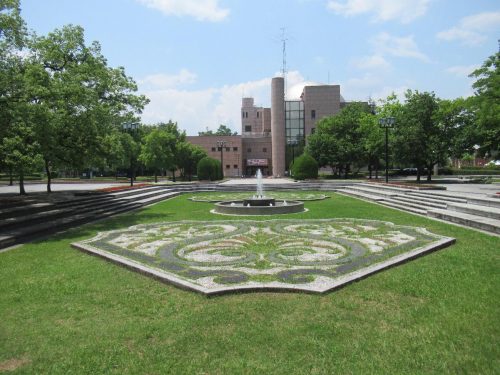
The fact that Hannover is Hiroshima’s German sister city is conspicuously reflected in Hiroshima’s foreigner population. Quite a few Germans living and working here are from Hannover, and both public and private events are held periodically to bring all German-speakers in Hiroshima together regardless of country of origin, so anybody in this city with even an inkling of interest in German culture will eventually get to know a Hanoverian. The Hannover Garden above is modeled after a real landmark in their city, the Herrenhausen Gardens, and while Hiroshima’s version doesn’t hold a candle to the real deal, this verdant space is beloved by the locals and may spark somebody’s interest to pay a visit to Hiroshima’s German sister out of curiosity.
Trek to Hannover
After over two years, I finally had the opportunity and time to take a trip overseas, especially after re-entry regulations for residents in Japan were relaxed in early September. 2022 is indeed the year of revenge travel, wherein tourists (myself not excluded) have exploited every deal and made plans to satisfy their lust to travel the world. To reach Germany, it was a simple hop from Hiroshima Airport to Narita Airport, and from Narita to Frankfurt. I had planned a tour of the western part of the country and managed to squeeze in one afternoon to take a train to see Hannover, and in all honestly it felt more like visiting a relative than pure tourism.
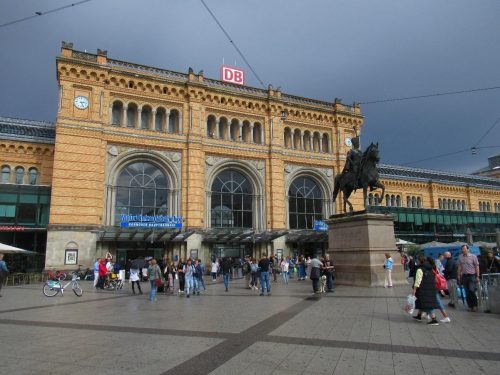
Since Hiroshima gave a shout-out to Hannover via the Hannover Garden, I was expecting the feeling to be mutual, and researched sights in Hannover that mention her sister city in Japan. The Herrenhausen Gardens off which the Hannover Garden was based seemed to have no reference to Hiroshima whatsoever, but there is Hiroshima-Hain auf der Bult, a Japanese garden in the eastern part of the city that apparently hosts lots of sakura. However, it wasn’t the time for cherry blossom viewing, which meant that the garden wouldn’t look its best were I to visit. If I were to drop by in say, April, Hiroshima-Hain auf der Bult would probably look a little something like this.

In the end, I decided on the Neues Rathaus (New Town Hall), since if any tourist attraction in Hannover would name any sister cities at all, it would be a government building. In addition, the ornate edifice was surrounded by an expansive pond called the “Maschteich” and a vast park, so I could easily spend the entirety of my day trip there alone. In order to enjoy my time at said park thoroughly, I bought some food at a train station that I could eat with ease before boarding my train bound for Hannover, patiently waiting for the most opportune moment to chow down. From Hannover Hauptbahnhof (Central Railway Station), it’s a bit of a trek to the Rathaus, but just use your favorite map application and it won’t be hard to find. From the basement of Hannover Station, I walked through the shopping complex that led all the way to the next subway station before ascending to street level again. After that, it’s just a couple turns in a commercial district before finally arriving to this.
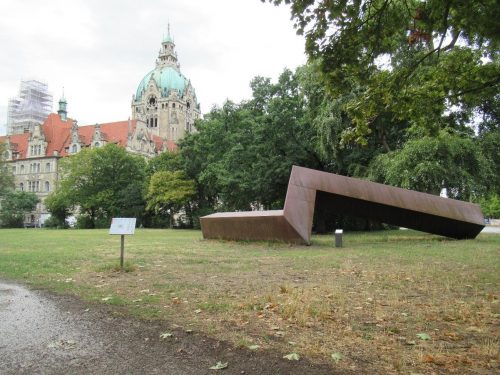
This was the northeastern entrance to the park surrounding the town hall, and because I knew I still had a bit of a way to go before getting to the building itself, it was at this point that I got an idea of the town hall’s immense size. A few more paces down a dirt path took me to the building’s south side, which faces the Maschteich. The two towers to the side were covered in scaffolding due to renovation work, but the covered portions didn’t distract too much from the overall appeal of the Rathaus.
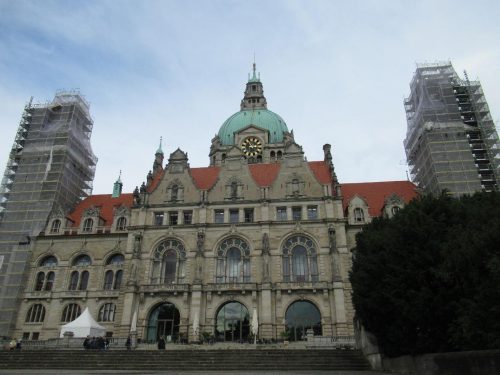
They’ve got tables right outside the doors for outdoor eating, and when one goes down those steps, the pond will be right in front of them, shining like the forest’s mirror. To the left and right of the picture above, there are also your typical park benches where visitors sit and relax, and there are several other paths around the park circling the pond to allow for better views of the Rathaus, but more on that later. In any case, I figured that if the back side of the building was already this marvelous, the front side ought to be more of a beaut! It actually took me a few minutes to circle around to the other side of the building, but I was delighted to be right about my gut feeling. In place of the pond, there is now a wide, open plaza lined with black and white tiles, and the façade has more miniature towers sporting those oxidized copper roofs that lend to the building’s age.
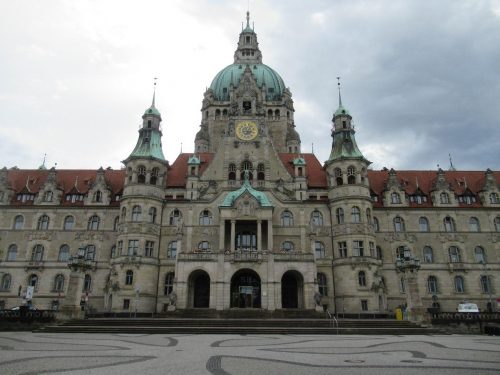
Hall of Fame
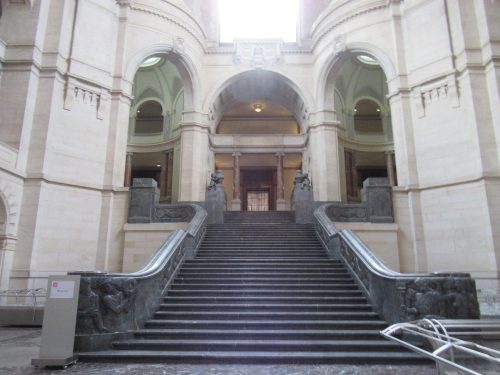
I stepped through the front doors of the Rathaus and into the main chamber, and was astonished by what met my eyes on the ground floor alone! The first thought on my mind was that I picked an excellent tourist attraction to spend what little time I had in Hannover, but the second thought on my mind was, “does a town hall need to be this gargantuan and grandiose?” Like a normal town hall in any city, there is a directory near the entrance detailing where the various facilities are, but in this one, you really need to read it before moving on so you can efficiently find everything in this humongous edifice. The main chamber was as spacious as a ballroom with the appropriate marble flooring and walls to boot, with models of the city during various points in history and an imposing marble staircase leading to the next level.
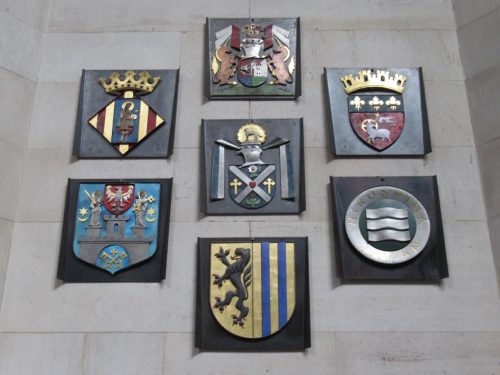
I did a 180-degree turn and looked at the wall on the left, where I saw some coats of arms, and I immediately knew what they were referring to. From the center, going down and clockwise, we have the coats of arms of Blantyre, Malawi, Leipzig, Germany, Poznań, Poland, Perpignan, France, Bristol, the United Kingdom, Rouen, France, and last but not least, our very own Hiroshima City in Japan. Below these plaques was a table set up with a photo of the late Queen Elizabeth II and a condolence book as Her Majesty had only passed away the day before. Almost every visitor today took out the time to write something in the book in honor of the longest-reigning British monarch, so that everyone’s thoughts would be passed from the City of Hannover to the City of Bristol.
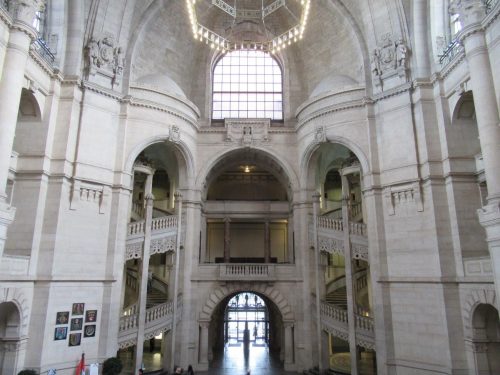
After having captured Hannover’s mention of Hiroshima on camera, I proceeded to explore the rest of the Rathaus. I thought the view of the staircase itself was stunning until I climbed the stairs and looked back toward the entrance to find an even more breathtaking sight. This place was starting to feel less like where the locals get their official paperwork processed and more like a royal palace or even a video game stage. I took the spiral staircase to the right in the picture above to access the roof, but there wasn’t much to see from there (at least, not for free). There wasn’t enough time in my day for me to go back down, buy a ticket, and wait in line to be taken to the very top platform just to catch a brief glimpse of the city from above. I decided to make due with the grand interior I already saw, and went back outside the explore the park some more.
Paths of Sisterhood

Back at the back side of the Rathaus, I plopped down on a bench near the Maschteich and voraciously devoured my food since it was well past lunch time. With energy back in my body, I was ready to tackle the walking trails crisscrossing through the park grounds. One interesting thing to note about these paths is that there are seven designated ways named after Hannover’s sister cities. Case in point, I traversed Bristol Way to the back entrance of the Rathaus, and was about to meander down Rouen Way, which hugs the east end of the pond. That path then merges into Hiroshima Way, which possesses a bridge for crossing over the Maschteich to the southern edge of the pond.

It was around this time that the views of the Rathaus gradually became more and more magical because thanks to the Maschteich, visitors are now gazing upon two town halls in one scene. Having sunny skies and not too many disturbances on the surface of the water made the mirror image even prettier, and I wasn’t even on the opposite side of the building yet. Readers probably won’t be at all surprised to know that every year on August 6th (the anniversary of the atomic bombing on Hiroshima), a lantern-floating event is held right here just like on the Motoyasu River right in front of the Atomic Bomb Dome.
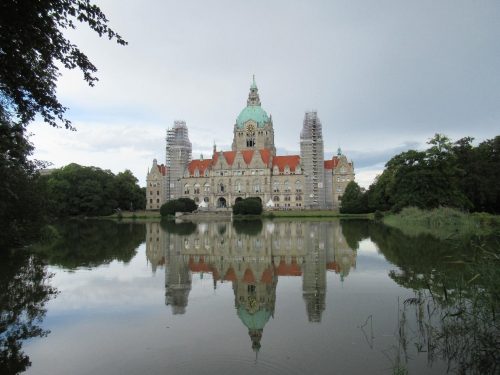
Moment of Joy: Mutual Care
Not to be overlooked, the scenery on the paths themselves is serene and added to my overall enjoyment of the park. I enjoyed my time on Hiroshima Way, which eventually gave way to Poznań Way as I turned onto the path opposite the Rathaus. Along the way, I met some ducks peacefully going about their business as they silently picked bits of food off the ground. I progressed along the perimeter of the Maschteich until I was looking at the Rathaus face to face, and was able to take the one photo of this place that indubitably trumped every other photo I took that day.
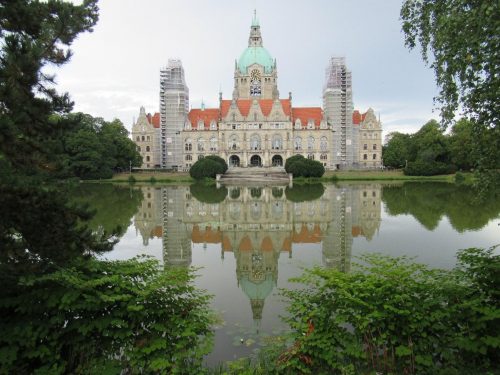
Hiroshima’s German Connections
The city of Hannover is just the tip of the iceberg when it comes to interactions between Hiroshimarians and Germans. For instance, Baumkuchen, a German confection that is adored by Japanese consumers nationwide, was first baked on the island of Ninoshima (within the city limits of Hiroshima) by a German prisoner of war during World War I, then exhibited and sold for the first time at the building that would eventually become the Atomic Bomb Dome. In addition, downtown Hiroshima also hosts German-style events throughout the year that attract thousands of attendees, such as Oktoberfest beer fairs in late September, a German-style Christmas market in early and mid-December, and Hannover Day on May 27th, which was the day the sisterhood pact between the two cities was signed. The next Hannover Day will mark 40 years of sisterhood between Hannover and Hiroshima, and though it may feel like a long time still, I’m already eager to find out in what ways such a momentous anniversary will be celebrated.
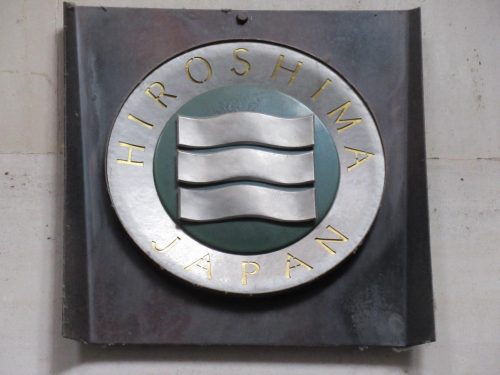
Given how many German cultural events take place in our peaceful city year after year, even in the midst of a pandemic, my hope for the future is to see an increase in interest in German culture among Hiroshimarians, and consequently, greater numbers of Japanese tourists in Hannover. I always found it comical how in spite of how famous Hiroshima is worldwide, your average Hiroshimarian isn’t all too aware of the workings of the world outside Japan, which is an honest shame. If more locals here are exposed to events that advertise Hiroshima’s sister cities, I’m certain their desire to visit them will be as great as mine. As for my recent visit to one of Hiroshima’s sisters, I had a trip to remember for sure, and dropping by to see the rest of the family is only a matter of time.
Written by the Joy in Hiroshima Team
